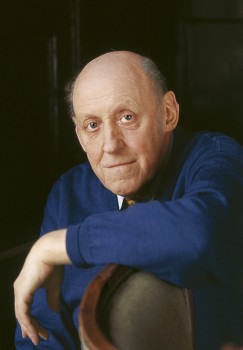Search results for "2011/04/2010/10/riikka-pulkkinen-totta-true"
Lars Levi Laestadius: Lappalaisten mytologian katkelmia [Fragments of Lapp mythology]
23 September 2011 | Mini reviews, Reviews
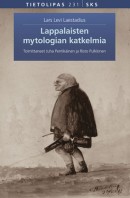 Lappalaisten mytologian katkelmia
Lappalaisten mytologian katkelmia
[Fragments of Lapp mythology]
Toimittaneet [Edited by]: Juha Pentikäinen ja Risto Pulkkinen
Suomentanut [Translated into Finnish by]: Risto Pulkkinen
Helsinki: Suomalaisen Kirjallisuuden Seura / the Finnish Literature Society: 400 p., ill.
ISBN 978-952-222-257-2
€ 28, paperback
The Swedish pastor Lars Levi Laestadius (1800–1861) is known as a preacher who criticised the dead dogma of the church and as the founder of Finland’s largest charismatic sect – although Laestadius did not even live in Finland. He was also a journalist who was active in the temperance movement and wrote a great deal of religious literature; Laestadius may be the best-known Sámi of all time. As well as an ecologist and botanist, he was also a philologist with a knowledge of the dialects of the Sámi language, and as an ethnographer Laestadius studied the history of the Sámi, collecting their beliefs into a system he called the Lapps’ mythology. It is only now that this work has been published in its entirety in Finnish. An expedition funded by Louis Philippe, king of France, in 1838–1840, played a decisive part in the birth of the work: Laestadius was appointed guide to the expedition, and a study of Lapp ‘history’ was commissioned from him. Part of the manuscript was long lost, but in 1946 it was discovered in the library of Yale University.
Translated by Hildi Hawkins
Serious comics: Angoulême 2011
24 February 2011 | This 'n' that
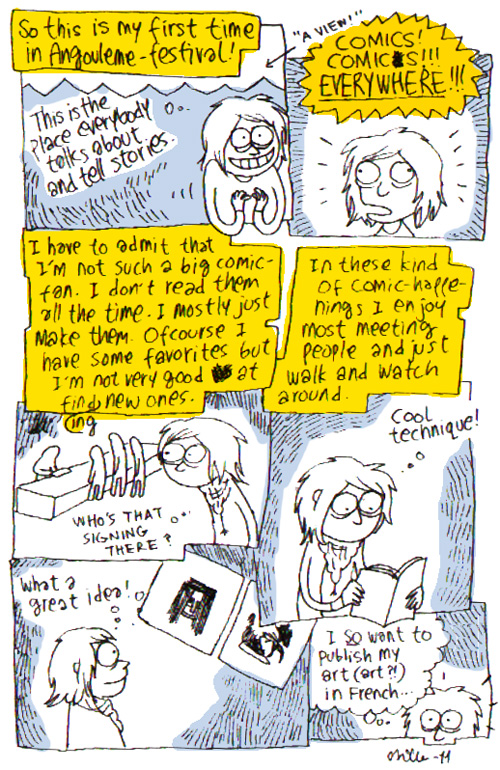
Graphic artist Milla Paloniemi went to Angoulême, too: read more through the link (Milla Paloniemi) in the text below
As a little girl in Paris, I dreamed of going to the Angoulême comics festival – Corto Maltese and Mike Blueberry were my heroes, and I liked to imagine meeting them in person.
20 years later, my wish came true – I went to the festival to present Finnish comics to a French audience! I was an intern at FILI – Finnish Literature Exchange, and for the first time, FILI had its own stand at Angoulême in January 2011.
Finnish comics have become popular abroad in recent years, which is particularly apparent in the young artists’ reception by readers in Europe. Angoulême isn’t just a comics Mecca for Europeans, however: there were admirers of Matti Hagelberg, Marko Turunen and Tommi Musturi from as far away as Japan and Korea.
The festival provides opportunities to present both general ‘official’ comics, ‘out-of-the-ordinary’ and unusual works. The atmosphere at the festival is much wilder than at a traditional book fair: for four days the city is filled with publishers, readers, enthusiasts, artists, and even musicians. People meet in the evenings at le Chat Noir bar to discuss the day’s finds, sketching their friends and the day’s events.
As one Belgian publisher told me, ‘There have always been Finns at Angoulême.’ Staff from comics publisher Kutikuti and many others have been making the rounds at Angoulême for years, walking through the city and festival grounds, carrying their backpacks loaded with books. They have been the forerunners to whom we are grateful, and we hope that our collaboration with them deepens in the future.

Aapo Rapi: Meti (Kutikuti, 2010)
This year two Finnish artists, Aapo Rapi and Ville Ranta were nominated for the Sélection Officielle prize, which gave them wider recognition. Rapi’s Meti is a colourful graphic novel inspired by his own grandmother Meti [see the picture right: the old lady with square glasses].
Hannu Lukkarinen and Juha Ruusuvuori were also favorites, as all the available copies of Les Ossements de Saint Henrik, the French translation of their adventures of Nicholas Grisefoth, sold out. There were also fans of women comics artists, searching feverishly for works by such artists as Jenni Rope and Milla Paloniemi.
Chatting with French publishers and readers, it became clear that Finnish comics are interesting for their freshness and freedom. Finnish artists dare to try every kind of technique and they don’t get bogged down in questions of genre. They said so themselves at the festival’s public event. According to Ville Ranta, the commercial aspect isn’t the most important thing, because comics are still a marginalised art in Finland. Aapo Rapi claimed that ‘the first thing is to express my own ideas, for myself and a couple of friends, then I look to see if it might interest other people.’
Hannu Lukkarinen emphasised that it’s hard to distribute Finnish-language comics to the larger world: for that you need a no-nonsense agent like Kirsi Kinnunen, who has lived in France for a long time doing publicity and translation work. Finnish publishers haven’t yet shown much interest in marketing comics, but that may change in the future.
These Finnish artists, many of them also publishers, were happy at Angoulême. Happy enough, no doubt, to last them until next year!
Translated by Lola Rogers
What are we like?
4 February 2011 | Non-fiction, Tales of a journalist

To be, or not, a true Finn? Illustration: Joonas Väänänen

To be, or not, a true Finn? Illustration: Joonas Väänänen
Elections are coming: what will the vox populi, the voice of the people, dictate? And which people will be deciding Finland’s political future? As columnist Jyrki Lehtola reports, a political debate has arisen about the ‘right’ and the ‘wrong’ sort of pollster – and the ‘right’ and ‘wrong’ kind of Finn
Finland will be holding parliamentary elections in April. We’ve been organising them every four years, like clockwork, for the past two decades, a rare example of stability in a parliamentary democracy. Finland is the European Union’s model student, and the differences between our main political parties are nearly pro forma (who wouldn’t want to protect nature? who wouldn’t want better health care?), so elections in recent years have been more like an endearing tradition than significant, world-changing events.
However, this year everything is different. The upcoming elections have forced us to look in the mirror – and we aren’t liking what we’re seeing. More…
Best Translated Book Award 2011
13 May 2011 | In the news
 Thomas Teal’s translation from Swedish into English of Tove Jansson’s novel Den ärliga bedragaren (Schildts, 1982), entitled The True Deceiver (published by New York Review Books, 2009), won the 2011 Best Translated Book Award in fiction (worth $5,000; supported by Amazon.com). The winning titles and translators for this year’s awards were announced on 29 April in New York City as part of the PEN World Voices Festival.
Thomas Teal’s translation from Swedish into English of Tove Jansson’s novel Den ärliga bedragaren (Schildts, 1982), entitled The True Deceiver (published by New York Review Books, 2009), won the 2011 Best Translated Book Award in fiction (worth $5,000; supported by Amazon.com). The winning titles and translators for this year’s awards were announced on 29 April in New York City as part of the PEN World Voices Festival.
Organised by Three percent (the link features a YouTube recording from the award ceremony, introducing the translator, Thomas Teal [fast-forward to 7.30 minutes]) at the University of Rochester, and judged by a board of literary professionals, the Best Translated Book Award is ‘the only prize of its kind to honour the best original works of international literature and poetry published in the US over the previous year’. ‘Subtle, engaging and disquieting, The True Deceiver is a masterful study in opposition and confrontation’, said the jury.
Tove Jansson (1914–2001), mother of the Moomintrolls, story-teller and illustrator of children’s books, translated into 40 languages, began to write novels and short stories for adults in her later years. Psychologically sharp studies of relationships, they are written with cool understatement and perception.
Quality writing will work its way into a wider knowledge (i.e. a bigger language and readership) eventually… even though occasionally it may seem difficult to know where exactly it comes from; in a review published in the London Guardian newspaper, the eminent writer Ursula K. Le Guin assumed Tove Jansson was Swedish.
Finlandia Prize candidates 2011
17 November 2011 | In the news
 The candidates for the Finlandia Prize for Fiction 2011 are Eeva-Kaarina Aronen, Kristina Carlson, Laura Gustafsson, Laila Hirvisaari, Rosa Liksom and Jenni Linturi.
The candidates for the Finlandia Prize for Fiction 2011 are Eeva-Kaarina Aronen, Kristina Carlson, Laura Gustafsson, Laila Hirvisaari, Rosa Liksom and Jenni Linturi.
Their novels, respectively, are Kallorumpu (‘Skull drum’, Teos), William N. Päiväkirja (‘William N. Diary’, Otava), Huorasatu (‘Whore tale’, Into), Minä, Katariina (‘I, Catherine’, Otava), Hytti no 6 (‘Compartment number 6’, WSOY) and Isänmaan tähden (‘For fatherland’s sake’, Teos).
Kallorumpu takes place in 1935 in Marshal Mannerheim’s house in Helsinki and in the present time. Laila Hirvisaari is a popular writer of mostly historical fiction: Minä, Katariina, a portrait of Russia’s Catherine the Great, is her 39th novel. Gustafsson’s and Linturi’s novels are first works; the former is a bold farce based on women’s mythology, the latter is about guilt born of the Second World War.
The jury – journalist and critic Hannu Marttila, journalist Tuula Ketonen and translator Kristiina Rikman – made their choice out of 130 novels. The winner, chosen by the theatre manager of the KOM Theatre Pekka Milonoff, will be announced on the first of December. The prize is worth 30,000 euros. It has been awarded since 1984, to novels only from 1993.
The fact that this time all the candidates are women has naturally been the object of criticism: why are the popular male writers’ books of 2011 missing from the list?
Another thing that these novels share is history: five of them are totally or partially set in the past – Finland in 1935, Paris in the 1890s, Russia/Soviet Union in the 18th century and in the 1980s, and 1940s Finland during the Second World War. Even the sixth, Huorasatu, bases its depiction of the present day in women’s prehistory, patriarchy and the ancient myths.
The jury’s chair, Hannu Marttila, commented: ‘This book year is sure to be remembered for a generational and gender change among those who write literature about the Second World War in Finland. Young woman writers describe the war with probably greater diversity than before. From the non-fiction writing of recent years it is clear that the struggles and difficulties of the home front are increasingly being recognised as part of the general struggle for survival, and on the other hand the less heroic aspects of war, the shameful and criminal elements, have also become acceptable as objects of study.’
Marttila concluded his speech: ‘When picking mushrooms in the forest, I have learned that it is often worth humbly peeking under the grass, and that the most glaring cap is not necessarily the best…. Perhaps it is time to forget the old saying that there is literature, and then there is women’s literature.’
Success after success
9 March 2012 | This 'n' that
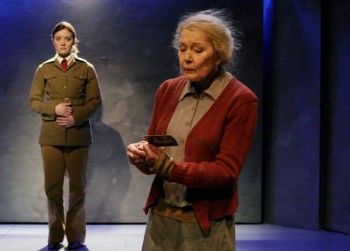
The women of Purge: Elena Leeve and Tea Ista in Sofi Oksanen's Puhdistus at the Finnish National Theatre, directed by Mika Myllyaho. Photo: Leena Klemelä, 2007
Sofi Oksanen’s Purge, an unparalleled Finnish literary sensation, is running in a production by Arcola Theatre in London, from 22 February to 24 March.
First premiered at the Finnish National Theatre in Helsinki in 2007, Puhdistus, to give it its Finnish title, was subsequently reworked by Oksanen (born 1977) into a novel – her third.
Puhdistus retells the story of her play about two Estonian women, moving through the past in flashbacks between 1939 and 1992. Aliide has experienced the horrors of the Stalin era and the deportation of Estonians to Siberia, but has to cope with the guilt of opportunism and even manslaughter. One night in 1992 she finds a young woman in the courtyard of her house; Zara has just escaped from the claws of members of the Russian mafia who held her as a sex slave. (Maya Jaggi reviewed the novel in London’s Guardian newspaper.) More…
Best-selling books in September
18 October 2012 | In the news
Number one on the September list of best-selling Finnish fiction titles, compiled by the Finnish Booksellers’ Association, is Sofi Oksanen’s new novel Kun kyyhkyset katosivat (‘When the doves disappeared’, Like): which shot straight to the top of the list on its publication in August.
The huge national and international success of her previous novel, Puhdistus – in English, Purge – published in 2008 and also set in Estonia, has paved the way for Kun kyyhkyset katosivat; translation rights have been sold to several countries already.
Number two on the list was Riikka Pulkkinen’s third novel, Vieras (‘The stranger’, Otava). In third and fourth places were two new thrillers, Paholaisen pennut (‘The devil’s cubs’, Tammi), by Leena Lehtolainen, and Ylösnousemus (‘Resurrection’, WSOY), by Ilkka Remes.
In fifth place was Sirpa Kähkönen’s novel Hietakehto (‘Sand cradle’, Otava): number six in her series set in the Kuopio region of eastern Finland, during the Second World War.
The non-fiction (translated foreign as well as Finnish) list was topped by Blaine Harden’s Escape from Camp 14 (in North Korea; Gummerus). The variety of subjects on this list can be surprising: number two is about angels (Lorna Byrne’s A Message of Hope from the Angels, Otava), number three a biography of a Finnish ex-con turned surgeon (Veitsen terällä, ‘On knife’s edge’, by Arno Kotro & Christer Lybäck, Otava), number four about the Cold War in Finland (Jukka Tarkka: Karhun kainalossa, ‘Under the arm of the bear’, Otava) and number five about cupcakes (by Angela Drake, Otava)…
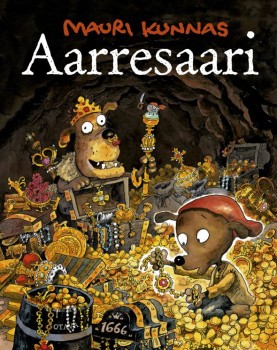
Mauri Kunnas: Aarresaari
The three best-selling children’s books were by seasoned Finnish authors: illustrator-writer Mauri Kunnas, with his tribute to R.L Stevenson, Aarresaari (‘Treasure island’, Otava), Aino Havukainen & Sami Toivonen, with Tatu ja Patu pihalla (‘Tatu and Patu outdoors’, Otava) and Sinikka Nopola & Tiina Nopola, with their Risto Räppääjä ja nukkavieru Nelli (‘Risto Rapper and Threadbare Nelly’, Tammi).
Funny stuff: best-selling books in February
13 March 2014 | In the news
 The list of best-selling books – compiled by the Finnish Booksellers’ Association – shows that in February comedy was popular among readers. Number one on the Finnish fiction list was Fingerpori 7 (‘Fingerborg 7’, Arktinen Banaani), the latest comics book by Pertti Jarla, featuring silly stuff taking place in the city of Fingerpori.
The list of best-selling books – compiled by the Finnish Booksellers’ Association – shows that in February comedy was popular among readers. Number one on the Finnish fiction list was Fingerpori 7 (‘Fingerborg 7’, Arktinen Banaani), the latest comics book by Pertti Jarla, featuring silly stuff taking place in the city of Fingerpori.
Riikka Pulkkinen’s new novel, a romantic comedy entitled Iiris Lempivaaran levoton ja painava sydän (‘Iiris Lempivaara’s restless and heavy heart’, Otava) which was originally published in a weekly women’s magazine, was number four. A satirical television series featuring two silly women devoted to dating and clubbing has also resulted in a book written by the two actresses, Heli Sutela and Minna Koskela: Anne ja Ellu lomamatkalla (‘Anne and Ellu on holiday’, published by Annen ja Ellun tuotanto) made its way to the seventh place. Number eight was Pertti Jarla’s Fingerborg 4!
However, number two was a first novel about problems arising in a religious family, Taivaslaulu (‘Heaven song’, Gummerus), by Pauliina Rauhala. Number three was a first novel by an immigrant Somali woman, Nura Farah: Aavikon tyttäret (‘Daughters of the desert’, Otava) tells the story of women in Somalia in the second half of the 20th century.
On the non-fiction list, among cookbooks and diet guides, books on how to maintain a hormonal balance or how to wield a kettlebell sold well. A new biography, Tove Jansson (Tammi), telling the life story of the Moomin genius (1914–2001), the artist, painter, author and cartoonist, was number seven; the author is Tuula Karjalainen. (The book will be published in several countries this year, a World English edition in December.)
At the top of the best-selling children’s books list is a book entitled Muumit ja tekemisen taika – ‘The Moomins and the magic of doing’ (Tammi). This ‘Moomin’ book is written by Clive Alan: we know absolutely nothing about him (he is absent from his publisher’s list of authors!) – except that the name is a pseudonym.
Well, as before, it is our opinion that all the Moomin books really worth reading were created by Tove Jansson herself.
Happy birthday to us!
13 February 2014 | Letter from the Editors

Picture: Wikipedia
It’s been five years since Books from Finland went online, and we’re celebrating with a little bit of good news.
In the past year, the number of visits to the Books from Finland website has grown by 11 per cent. The number of US and UK readers grew by 29 per cent, while the number of readers in Germany – stimulated perhaps by the publicity Finnish literature is attracting as a result of its Guest Country status at this year’s Frankfurt Book Fair – increased by an astonishing 59 per cent.
We’re chuffed, to put it mildly – and very thankful to you, dear readers, old and new. More…
Encounters with a language
12 December 2014 | Articles, Non-fiction
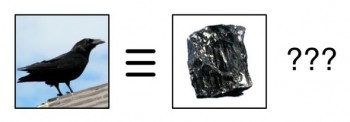
Mistranslation: illustration by Sminthopsis84/Wikimedia
Mother tongue: not Finnish. How do people become interested enough in the Finnish language in order to become translators? In the olden days some might have been greatly inspired by the music Sibelius (as were the eminent British translators of Finnish, David Barrett or Herbert Lomas, for example, back in the 1950s and 1960s). We asked contemporary translators to reminisce on how they in turn have become infatuated enough with Finnish to start studying and translating this small, somewhat eccentric northern language. Three translators into English, one into French, German and Latvian tell us why
The politics of difference
17 June 2011 | Non-fiction, Tales of a journalist
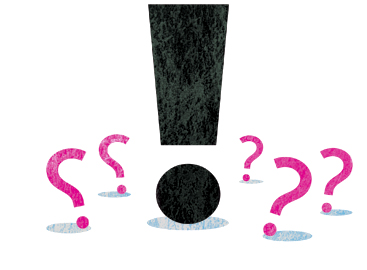
Right or wrong, my country? Illustration: Joonas Väänänen

Right or wrong, my country? Illustration: Joonas Väänänen
Big electoral turnouts are generally considered a good thing. But, writes columnist Jyrki Lehtola, in Finland the fact that the vote went up in the last Finnish general election caused a revelation. Educated urbanites and the media (perhaps near enough the same thing), are shocked by how 20 per cent of their fellow Finns think – and the ramifications caused tremors all across Europe
Listen up. Diversity is a resource. Except of course if it’s the sort of diversity that is a resource for the wrong people.
That sort of diversity isn’t the least bit nice. In Finland in the spring, we ran into the sort of diversity that even got the rest of Europe to start worrying. Out in the thickets and forests, diverse people had been springing up in secret, people of whose existence we urbanites were entirely unaware.
And they threatened to bring Europe down. Europe. Which was a bit much. More…
Finlandia Prize for Fiction 2011
1 December 2011 | In the news
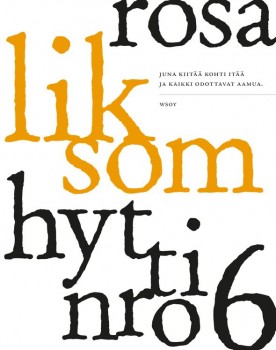 The winner of the Finlandia Prize for Fiction 2011, worth €30,000, is Rosa Liksom, for her novel Hytti no 6 (‘Compartment number 6’, WSOY): read translated extracts and an introduction of the author here on this page.
The winner of the Finlandia Prize for Fiction 2011, worth €30,000, is Rosa Liksom, for her novel Hytti no 6 (‘Compartment number 6’, WSOY): read translated extracts and an introduction of the author here on this page.
The prize was awarded on 1 December. The winner was selected by the theatre manager Pekka Milonoff from a shortlist of six.
‘Hytti nro 6 is an extraordinarily compact, poetic and multilayered description of a train journey through Russia. The main character, a girl, leaves Moscow for Siberia, sharing a compartment with a vodka-swilling murderer who tells hair-raising stories about his own life and about the ways of his country. – Liksom is a master of controlled exaggeration. With a couple of carefully chosen brushstrokes, a mini-story, she is able to conjure up an entire human destiny,’ Milonoff commented.
Author and artist Rosa Liksom (alias Anni Ylävaara, born 1958), has since 1985 written novels, short stories, children’s book, comics and plays. Her books have been translated into 16 languages.
Appointed by the Finnish Book Foundation, the prize jury (journalist and critic Hannu Marttila, journalist Tuula Ketonen and translator Kristiina Rikman) shortlisted the following novels: Kallorumpu (‘Skull drum’, Teos) by Eeva-Kaarina Aronen, William N. Päiväkirja (‘William N. Diary’, Otava) by Kristina Carlson, Huorasatu (‘Whore tale’, Into) by Laura Gustafsson, Minä, Katariina (‘I, Catherine’, Otava) by Laila Hirvisaari, and Isänmaan tähden (‘For fatherland’s sake’, first novel; Teos) by Jenni Linturi.
Rosa Liksom travelled a great deal in the Soviet Union in the 1980s. She said she hopes that literature, too, could play a role in promoting co-operation between people, cultures and nations: ‘For the time being there is no chance of some of us being able to live on a different planet.’
Government Prize for Translation 2011
24 November 2011 | In the news
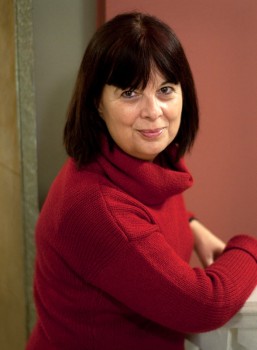
María Martzoúkou. Photo: Charlotta Boucht
The Finnish Government Prize for Translation of Finnish Literature of 2011 – worth € 10,000 – was awarded to the Greek translator and linguist María Martzoúkou.
Martzoúkou (born 1958), who lives in Athens, where she works for the Finnish Institute, has studied Finnish language and literature as well as ancient Greek at the Helsinki University, where she has also taught modern Greek. She was the first Greek translator to publish translations of the Finnish epic, the Kalevala: the first edition, containing ten runes, appeared in 1992, the second, containing ten more, in 2004.
‘Saarikoski was the beginning,’ she says; she became interested in modern Finnish poetry, in particular in the poems of Pentti Saarikoski (1937–1983). As Saarikoski also translated Greek literature into Finnish, Martzoúkou found herself doubly interested in his works.
Later she has translated poetry by, among others, Tua Forsström, Paavo Haavikko, Riina Katajavuori, Arto Melleri, Annukka Peura, Pentti Saaritsa, Kirsti Simonsuuri and Caj Westerberg.
Among the Finnish novelists Martzoúkou has translated are Mika Waltari (five novels; the sixth, Turms kuolematon, The Etruscan, is in the printing press), Väinö Linna (Tuntematon sotilas, The Unknown Soldier) and Sofi Oksanen (Puhdistus, Purge).
María Martzoúkou received her award in Helsinki on 22 November from the minister of culture and sports, Paavo Arhinmäki. Thanking Martzoúkou for the work she has done for Finnish fiction, he pointed out that The Finnish Institute in Athens will soon publish a book entitled Kreikka ja Suomen talvisota (‘Greece and the Finnish Winter War’), a study of the relations of Finland and Greece and the news of the Winter War (1939–1940) in the Greek press, and it contains articles by Martzoúkou.
The prize has been awarded – now for the 37th time – by the Ministry of Education and Culture since 1975 on the basis of a recommendation from FILI – Finnish Literature Exchange.
Helsinki Book Fair 2011
2 November 2011 | In the news
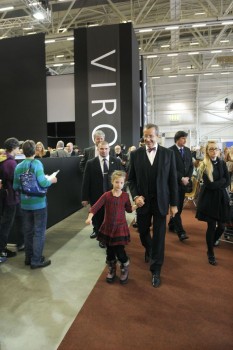
President Toomas Hendrik Ilves at the Book Fair: Viro is Estonia in Finnish. Photo: Kimmo Brandt/The Finnish Fair Corporation
The Helsinki Book Fair, held from 27 to 30 October, attracted more visitors than ever before: 81,000 people came to browse and buy books at the stands of nearly 300 exhibitors and to meet more than a thousand writers and performers at almost 700 events.
The Music Fair, the Wine, Food and Good Living event and the sales exhibition of contemporary art, ArtForum, held at the same time at Helsinki’s Exhibition and Convention Centre, expanded the selection of events and – a significant synergetic advantage, of course – shopping facilities. Twenty-eight per cent of the visitors thought this Book Fair was better than the previous one held in 2010.
According to a poll conducted among three hundred visitors, 21 per cent had read an electronic book while only 6 per cent had an e-book reader of their own. Twenty-five per cent did not believe that e-books will exceed the popularity of printed books, and only three per cent believed that e-books would win the competition.
Estonia was the theme country this time. President Toomas Hendrik Ilves of the Republic of Estonia noted in his speech at the opening ceremony: ‘As we know well from the fate of many of our kindred Finno-Ugric languages, not writing could truly mean a slow national demise. So publish or perish has special meaning here. Without a literary culture, we would simply not exist and we have known this for many generations, since the Finnish and Estonian national epics Kalevala and Kalevipoeg. – During the last decade, more original literature and translations have been published in Estonia than ever before. And we need only access the Internet to glimpse the volume of text that is not printed – it is even larger than the printed corpus. We live in an era of flood, not drought, and thus it is no wonder that as a discerning people, we do not want to keep our ideas and wisdom to ourselves but try to share and distribute them more widely. The idea is not to try to conquer the world but simply, with our own words, to be a full participant in global literary culture, and in the intellectual history and future of humankind.’
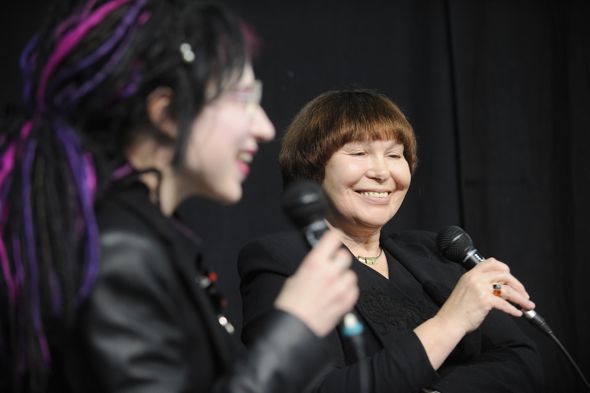
Finland meets Estonia: authors Sofi Oksanen and Viivi Luik in discussion. Photo: Kimmo Brandt/The Finnish Fair Corporation

